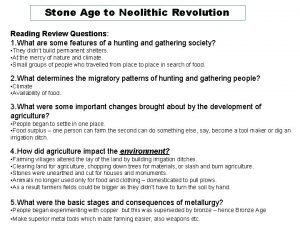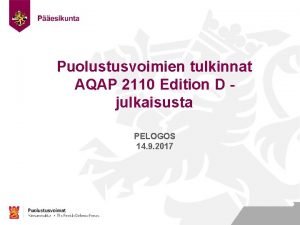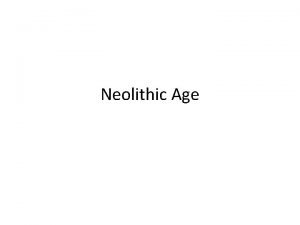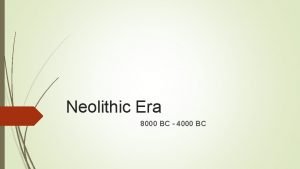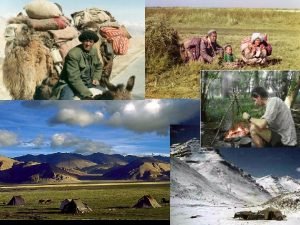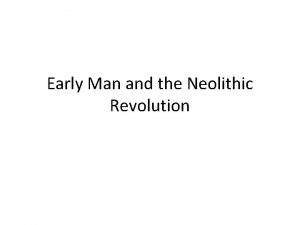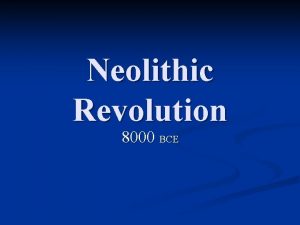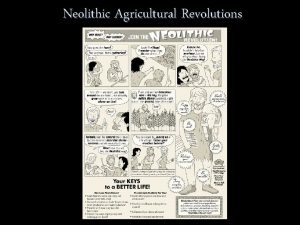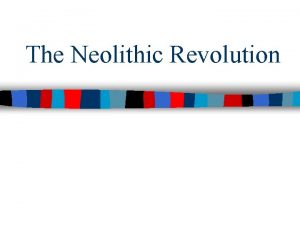Neolithic Period The Neolithic period was the latest












- Slides: 12

Neolithic Period • The Neolithic period was the latest part of the Stone Age, beginning about 10, 700 years ago and ending with the beginning of the Bronze Age in about 3500 B. C. E. • During the Neolithic period, settled agriculture began in the Middle East as people started to plant grain, breed and herd animals, and use agricultural tools.

Important Terms • Scarcity: The condition that exists because human wants are greater than the capacity of available resources to satisfy those wants. The problem of scarcity faces all individuals and organizations throughout time. • Standard of living: How well off people are, as measured by the quantity and quality of goods and services that they have.

Important Terms • Consumer goods: Goods that give you direct satisfaction. Examples from the simulation: Wheat, clothes, and houses • Capital goods: Human-made goods that are used to produce other goods and services and that do not get used up in the production process. Examples from the simulation: Pointed sticks, hoes, sickles, and irrigation canals

Important Terms • Investment: The purchase of capital goods that are used to produce goods and services.

Your Goal in the Simulation • Your goal in the simulation is to raise your standard of living by acquiring consumer goods. You want to have: ü 20 units of wheat ü 10 woolen garments ü 1 mud-brick house Note: You do not win the simulation by accumulating capital goods. However, capital goods can help you produce wheat in less time, which will give you the time you need to make woolen garments and build a mud-brick house.

Information for the Simulation • Your family must have 20 units of wheat each year to survive. • 1 woolen garment costs 2 units of wheat. (You want 10 woolen garments. ) • 1 mud-brick house costs 20 units of wheat. (You want 1 mud-brick house. )

Information for the Simulation • 1 hoe costs 3 units of wheat. Each hoe you own increases wheat production by 8 units per year. • 1 sickle costs 2 units of wheat. Each sickle you own increases wheat production by 5 units per year. • 1 irrigation canal costs 20 units of wheat. It costs only 15 units per family if two families produce it together. A canal system increases wheat production by 20 units per year.

Family Record Sheet: Part 1 YEAR ____ Units of wheat stored from prior years: ______ Units of wheat produced this year without capital goods: ______ Units of wheat produced this year from capital goods: ______ Total wheat you have (sum of the above): ______ (announced by teacher at beginning of year) (number of hoes times 8; plus number of sickles times 5; plus 20 if you own an irrigation canal) Total wheat that you have _____ minus 20 units consumed = _____ extra units this year

Family Record Sheet: Part 2 DECISION ABOUT EXTRA UNITS OF WHEAT THIS YEAR: o o o units stored in case of drought 2 units exchanged per woolen garment 20 units exchanged for a mud-brick house 3 units exchanged per hoe 2 units exchanged per sickle units exchanged for an irrigation canal AT THE END OF THE YEAR, WE WILL OWN _____ WOOLEN GARMENTS AND _____ MUD-BRICK HOUSES _____ _____

Debriefing the Simulation • How could Neolithic farmers increase the overall production of consumer goods? • How did producing capital goods lead to an increased standard of living?

Debriefing the Simulation • Labor productivity is the amount of goods and services produced per worker in a given time period. o Did your family size change during the simulation? o By the end of the simulation, could your family produce more wheat in a year? o Did wheat produced person increase? o Why did productivity increase in the simulation?

Debriefing the Simulation • Economic growth is an increase in the output of goods and services person. o How did using capital goods affect economic growth? o How does economic growth affect the standard of living?
